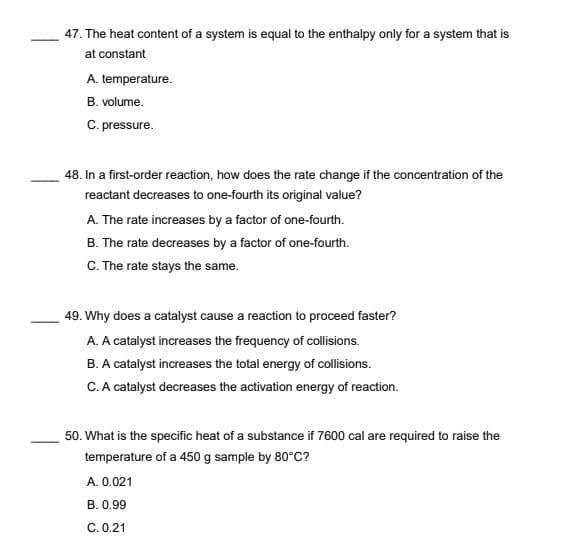47. The heat content of a system is equal to the enthalpy only for a system that is at constant A. temperature. B. volume. C. pressure. 48. In a first-order reaction, how does the rate change if the concentration of the reactant decreases to one-fourth its original value? A. The rate increases by a factor of one-fourth. B. The rate decreases by a factor of one-fourth. C. The rate stays the same. 49. Why does a catalyst cause a reaction to proceed faster? A. A catalyst increases the frequency of collisions. B. A catalyst increases the total energy of collisions. C. A catalyst decreases the activation energy of reaction. 50. What is the specific heat of a substance if 7600 cal are required to raise the temperature of a 450 g sample by 80°C? A. 0.021 B. 0.99 C. 0.21
47. The heat content of a system is equal to the enthalpy only for a system that is at constant A. temperature. B. volume. C. pressure. 48. In a first-order reaction, how does the rate change if the concentration of the reactant decreases to one-fourth its original value? A. The rate increases by a factor of one-fourth. B. The rate decreases by a factor of one-fourth. C. The rate stays the same. 49. Why does a catalyst cause a reaction to proceed faster? A. A catalyst increases the frequency of collisions. B. A catalyst increases the total energy of collisions. C. A catalyst decreases the activation energy of reaction. 50. What is the specific heat of a substance if 7600 cal are required to raise the temperature of a 450 g sample by 80°C? A. 0.021 B. 0.99 C. 0.21
Chemistry for Engineering Students
4th Edition
ISBN:9781337398909
Author:Lawrence S. Brown, Tom Holme
Publisher:Lawrence S. Brown, Tom Holme
Chapter11: Chemical Kinetics
Section: Chapter Questions
Problem 11.69PAE: In Chapter 3, we discussed the conversion of biomass into biofuels. One important area of research...
Related questions
Question
PLEASE COMPLETE ALL MSCQ THAN RATING HELPFUL

Transcribed Image Text:47. The heat content of a system is equal to the enthalpy only for a system that is
at constant
A. temperature.
B. volume.
C. pressure.
48. In a first-order reaction, how does the rate change if the concentration of the
reactant decreases to one-fourth its original value?
A. The rate increases by a factor of one-fourth.
B. The rate decreases by a factor of one-fourth.
C. The rate stays the same.
49. Why does a catalyst cause a reaction to proceed faster?
A. A catalyst increases the frequency of collisions.
B. A catalyst increases the total energy of collisions.
C. A catalyst decreases the activation energy of reaction.
50. What is the specific heat of a substance if 7600 cal are required to raise the
temperature of a 450 g sample by 80°C?
A. 0.021
B. 0.99
C. 0.21
Expert Solution
This question has been solved!
Explore an expertly crafted, step-by-step solution for a thorough understanding of key concepts.
Step by step
Solved in 5 steps

Knowledge Booster
Learn more about
Need a deep-dive on the concept behind this application? Look no further. Learn more about this topic, chemistry and related others by exploring similar questions and additional content below.Recommended textbooks for you

Chemistry for Engineering Students
Chemistry
ISBN:
9781337398909
Author:
Lawrence S. Brown, Tom Holme
Publisher:
Cengage Learning

General Chemistry - Standalone book (MindTap Cour…
Chemistry
ISBN:
9781305580343
Author:
Steven D. Gammon, Ebbing, Darrell Ebbing, Steven D., Darrell; Gammon, Darrell Ebbing; Steven D. Gammon, Darrell D.; Gammon, Ebbing; Steven D. Gammon; Darrell
Publisher:
Cengage Learning


Chemistry for Engineering Students
Chemistry
ISBN:
9781337398909
Author:
Lawrence S. Brown, Tom Holme
Publisher:
Cengage Learning

General Chemistry - Standalone book (MindTap Cour…
Chemistry
ISBN:
9781305580343
Author:
Steven D. Gammon, Ebbing, Darrell Ebbing, Steven D., Darrell; Gammon, Darrell Ebbing; Steven D. Gammon, Darrell D.; Gammon, Ebbing; Steven D. Gammon; Darrell
Publisher:
Cengage Learning


Chemistry
Chemistry
ISBN:
9781305957404
Author:
Steven S. Zumdahl, Susan A. Zumdahl, Donald J. DeCoste
Publisher:
Cengage Learning

Chemistry: An Atoms First Approach
Chemistry
ISBN:
9781305079243
Author:
Steven S. Zumdahl, Susan A. Zumdahl
Publisher:
Cengage Learning
